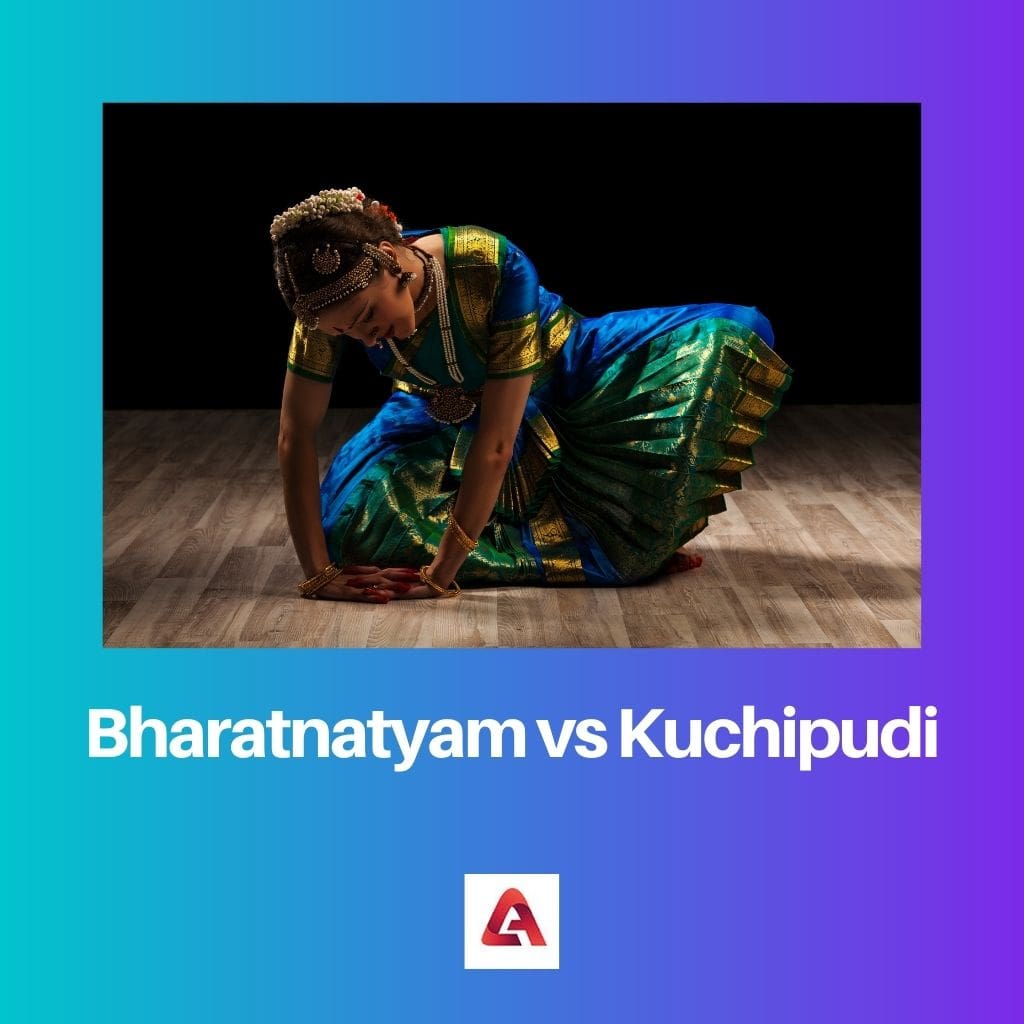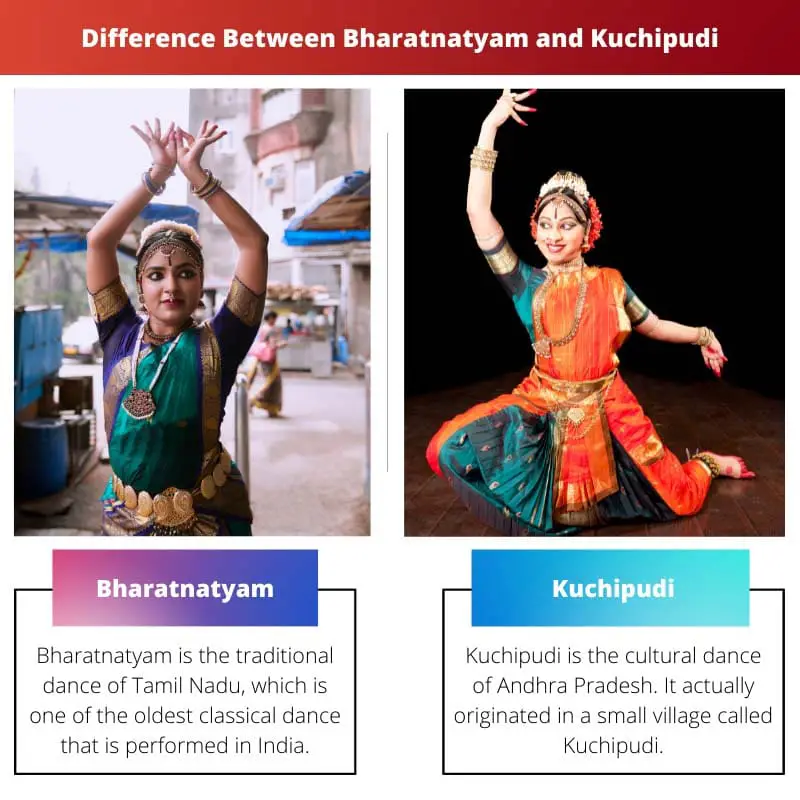Dance is a physical form of expression of creativity. A dancer uses body parts, facial expressions, and movements to express feelings and emotions and tell stories.
There are numerous forms of dance based on the dancing style, culture, etc. Many different cultures of the world have their unique dance styles.
Since India is a land of varying cultures. As a result, there are numerous cultural dance styles in this country. Two prominent dance styles are Bharatnatyam and Kuchipudi.
Now, it is easy to confuse which state has which dance style as their traditional dance form and what these styles portray.
Key Takeaways
- Bharatanatyam is a classical dance form originating in the southern Indian state of Tamil Nadu, known for its intricate footwork, hand gestures, and facial expressions; Kuchipudi is a classical dance form from the southeastern state of Andhra Pradesh, characterized by its narrative style and lively footwork.
- Bharatanatyam is more precise and geometrical, emphasizing symmetry and form; Kuchipudi is more fluid and expressive, emphasizing storytelling and emotion.
- Bharatanatyam costumes feature bright colors, traditional jewellery, and intricate makeup; Kuchipudi costumes are more minimalistic, focusing on simple yet elegant designs.
Bharatnatyam vs Kuchipudi
The difference between Bharatnatyam and Kuchipudi is that Bharatnatyam is the classical dance of Tamil Nadu, whereas Kuchipudi is the traditional dance of Andhra Pradesh.

Bharatnatyam is the traditional dance style of Tamil Nadu. It was earlier known as Sadira Attam, and its main aim was to express religious themes and spiritual ideas of South India, specifically Shaivism, Vaishnavism, and Shaktism.
Kuchipudi, on the other hand, is the traditional dance style of Andhra Pradesh. It originated in a village called Kuchipudi, located in the same state.
Like Bharatnatyam, Kuchipudi dramatizes the religious aspect of temples and spiritual beliefs of India.
Comparison Table
| Parameters of Comparison | Bharatnatyam | Kuchipudi |
|---|---|---|
| State | Tamil Nadu. | Andhra Pradesh. |
| Dance Method | Precise and rhythmic steps. | Rounded steps. |
| Dress | Has three fans of different lengths. | One fan is longer than the other, and the number of fans is not necessarily three. |
| Time of Origin | It is of ancient origin. | It is relatively younger than Bharatnatyam. |
| Elements in Focus | The element of Fire. | The element of Earth. |
What is Bharatnatyam?
Bharatnatyam is the traditional dance of Tamil Nadu, one of the oldest classical dances performed in India. It is one of the 8 officially recognized classical dances, the others being Kathak, Kuchipudi, Odissi, Kathakali, Mohiniyattram, Manipuri, and Sattriya.
The main characteristics of this dance form are flexed knees and bent legs. Also, the upper torso does not show much movement, and there is a lot of delicate footwork accompanied by plenty of sign language using hands, eyes, and facial muscles. Bharatnatyam expresses the religious message and practices that took place in South India.
It is accompanied by classical music, so Bharatnatyam is a team performance. There are the musicians, the singers, and the solo performer.
The dancer wears a colorful sari and jewelry and performs properly synchronized steps that follow the classical music that plays along with the performance. These movements try to communicate legends, religious ideas, and messages, prayers derived from or extracted from the shastras and other epics such as the Mahabharata and the Ramayana.
The total performance of Bharatnatyam follows a seven-part procedure. It goes in the following manner, Alarippu, Jatiswaram, Shabdam, Varnam, Padam, Tillana, Shlokam, or Mangalam.
Bharatnatyam is a dance of signs, and the signs portrayed using the hand are called mudras. Also, since Bharatnatyam is so deeply rooted in the ancient Indian culture, it is no surprise that plenty of yogic asanas are found when one performs Bharatnatyam.
Originally, Bharatnatyam’s music was Carnatic, involving instruments such as mridangam, cymbals, flutes, and veenas.

What is Kuchipudi?
Kuchipudi is the cultural dance of Andhra Pradesh. It originated in a small village called Kuchipudi in Andhra Pradesh, thus the name of the dance. Like Bharatnatyam, Kuchipudi is also one of India’s eight major classical dance forms.
It is based on the traditional Indian text of Natya Shashtra. It depicts the bards’ religious drama and messages and ancient India’s major spiritual beliefs.
Kuchipudi is based on the Krishna-oriented Vaishnavism tradition.
Originally, the dancers of Kuchipudi were a male troupe. The costume of the dance would be Angivastra and a dhoti.
When females dance, their costume is just a Sari and some light make-up. The sequence of performance of Kuchipudi starts with an invocation.
Each dancer has a specified role and performs a short preliminary act following the dance. Similar to Bharatnatyam, Kuchipudi too is performed with accompanying classical music.
However, contrary to Bharatnatyam, Kuchipudi has more rounded and graceful movements. The main instruments used in Kuchipudi are mridangam, flutes, violins, and tambura.
The performance is always led by the chief musician, traditionally called the Sutradhara, who beats the cymbal, thus determining the rhythm of the performance and also reciting musical syllables. There is also a clarinetist and violinist.
A flutist may be present too. There are various styles of Kuchipudi because of the varying creativity of the teachers who have taught it over the years.
The Margi and Desi have been around for a long time and have been mentioned in the Nrittaratnavali of Jaya Senapati. The Desi style is an openly more innovative version of the more conservative Margi style.

Differences Between Bharatnatyam and Kuchipudi
- The main difference between Bharatnatyam and Kuchipudi is that Bharatnatyam is the cultural dance of Tamil Nadu, while Kuchipudi is the traditional dance of Andhra Pradesh.
- Bharatnatyam has more precise and rhythmic steps, while Kuchipudi has more graceful and rounded steps.
- The dress of Bharatnatyam has three fans of different lengths. The Kuchipudi sari has varying fans, with one longer than the rest.
- Bharatnatyam focuses on the element of fire, while Kuchipudi focuses on the element of earth.
- Bharatnatyam is the oldest form of classical dance in India. Kuchipudi is relatively younger than Bharatnatyam

- https://www.researchgate.net/profile/Shankarashis_Mukherjee/publication/309211637_Effect_of_Regular_Practicing_Bharatnatyam_Dancing_Exercise_on_Body_Fat_of_Urban_Female_Teenagers/links/5805f64008aeb85ac85e3b65.pdf
- https://books.google.com/books?hl=en&lr=&id=Xa8FamiJJKgC&oi=fnd&pg=PA5&dq=kuchipudi&ots=QWeXbFvVJm&sig=5WqBIcVsSMemQoO8aZLwVV9uMBU.

The richness of Indian dance traditions comes to life through this captivating comparison of Bharatnatyam and Kuchipudi.
Well said, the portrayal of these dance forms is both enlightening and inspiring.
Amazing post! The detailed comparison between Bharatnatyam and Kuchipudi was very informative.
Great to see such rich cultural content being shared. Well done!
I agree, I’ve learned so much from this article!
I found the detailed comparison between Bharatnatyam and Kuchipudi to be enlightening. It’s important to preserve and celebrate the cultural heritage of these dances.
Absolutely, the attention to detail in the article is truly commendable.
This detailed comparison between Bharatnatyam and Kuchipudi is a great way to appreciate the diversity of Indian dance forms.
Absolutely, it’s important to recognize and celebrate the cultural heritage of different dance styles.
The narrative about Bharatnatyam and Kuchipudi provides an engaging perspective on the cultural significance of these dances.
I agree, the comparison is enlightening and educational.
Absolutely, the article offers a comprehensive understanding of these classical dance forms.
The intricate details about Bharatnatyam and Kuchipudi are truly fascinating. The cultural significance of these dance forms is beautifully depicted in this article.
Is this a dance class schedule? LOL!
It’s amazing how much can be learned from this article!
Hilarious, but it’s actually an insightful comparison of two Indian classical dance forms.
The detailed information presented about Bharatnatyam and Kuchipudi is exemplary. It sheds light on the artistic and cultural aspects of both dance forms.
Absolutely, the portrayal of Bharatnatyam and Kuchipudi through this post is commendable.
I couldn’t agree more. This article provides valuable insight into the rich traditions of Indian dance.
I appreciate the depth of information provided about the differences between Bharatnatyam and Kuchipudi. It allows for a greater understanding of these traditional dance styles.
I respectfully disagree with the comparison presented. The emphasis on the differences helps us appreciate the uniqueness of each dance form.
I understand your point, but I believe the article aimed to highlight the distinctions for educational purposes.